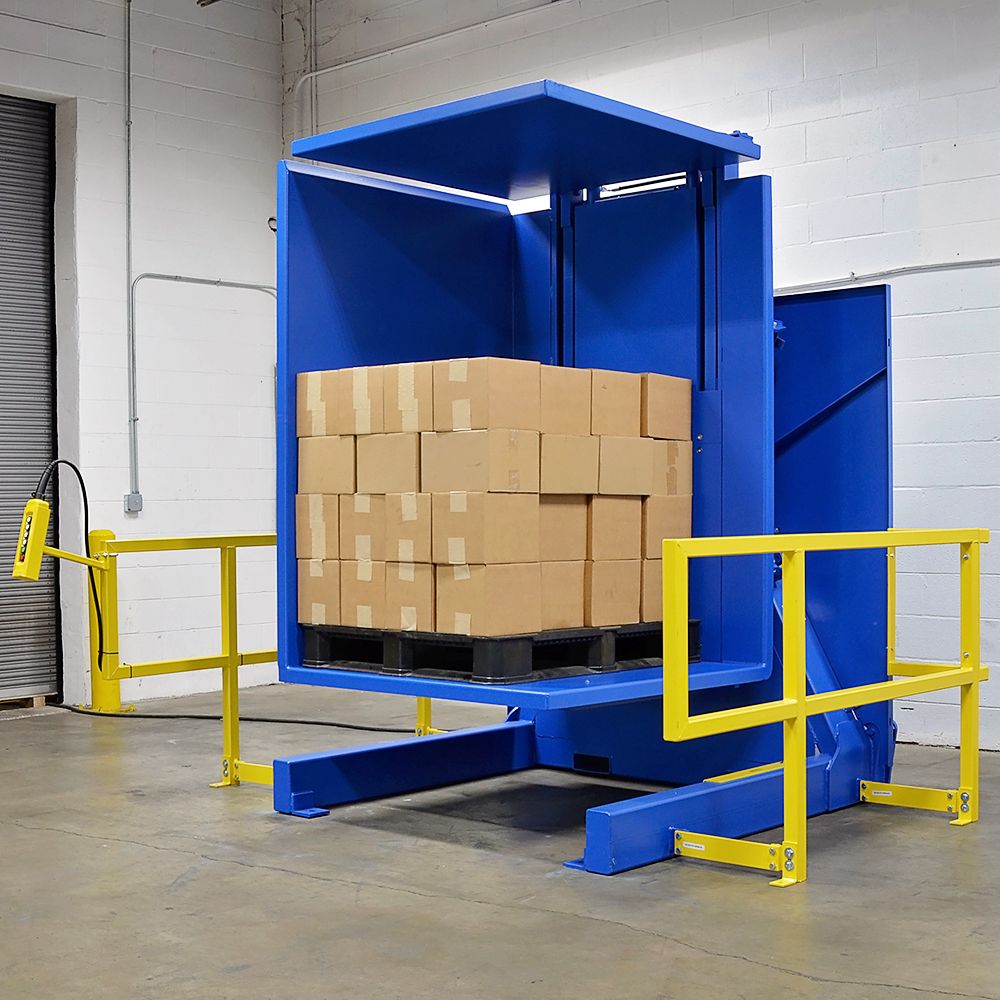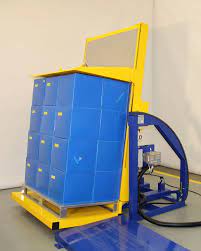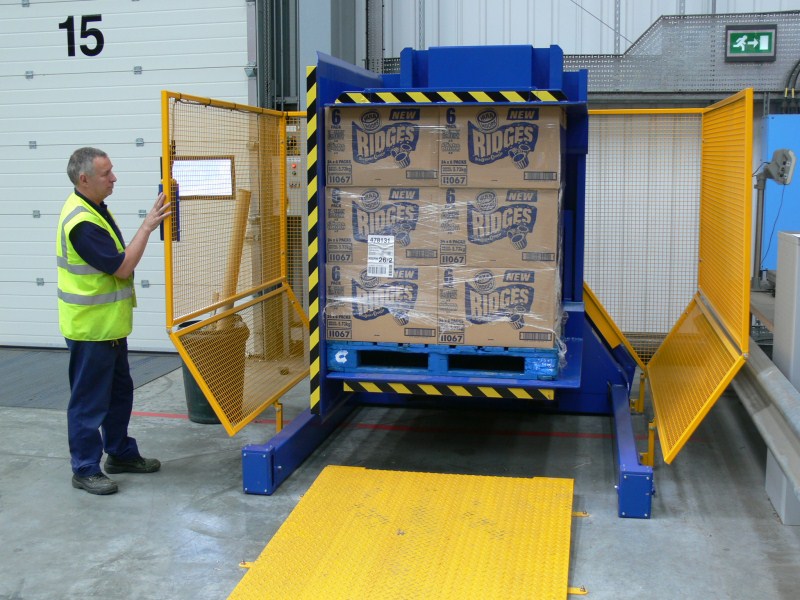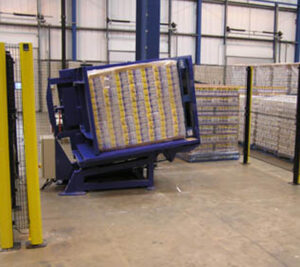What’s the ROI of Automated Pallet Changing Machines in Argentina's Steel Sector?
In Argentina's demanding steel industry, every operational detail matters. You are constantly balancing high energy costs, aging equipment, and fluctuating market demand. The pressure to improve efficiency and reduce costs is relentless. Manual processes, especially in logistics and packaging, can feel like a constant drain on resources. They are slow, require significant manpower, and expose your company to the risks of workplace accidents and product damage. Every time a worker has to manually re-stack a heavy load or a shipment is delayed because of a broken pallet, it eats directly into your profit margins. This is not just an inconvenience; it is a fundamental challenge to your goal of achieving lower operating costs and higher plant utilization. An automated pallet changing machine is not just another piece of hardware. It is a direct, strategic solution to these persistent problems, designed to deliver a measurable return on investment by tackling these issues at their core.
The ROI of an automated pallet changing machine in Argentina's steel sector is typically realized within 12 to 24 months. This rapid return is driven by a combination of direct labor cost reductions, a significant decrease in product damage, increased operational speed in your logistics chain, and a dramatic improvement in worker safety.

This payback period is a powerful number, but the real value is in understanding how you get there. The ROI isn't an abstract financial metric; it's the result of concrete, daily improvements on your factory floor. It comes from reassigning your valuable team members to higher-skilled jobs, from sending out perfect shipments every time, and from creating a safer, more predictable work environment. So, let’s break down exactly where these savings and efficiencies come from. We will explore how this technology addresses the specific challenges faced by steel plant owners like you.
How Do Automated Pallet Changers Directly Reduce Labor Costs and Improve Safety?
Manually transferring heavy products like steel wire coils or stacked metal sheets from one pallet to another is a difficult and time-consuming task. It often requires two or three workers to handle a single load, taking them away from more productive activities. This manual handling is not only slow but also one of the biggest sources of workplace injuries in any industrial setting. You worry about back strains, crushed feet, and other serious accidents. These incidents result in costly worker's compensation claims, lost workdays, and a drop in team morale. Your most valuable asset—your people—are engaged in low-value, high-risk work. An automated pallet changer, or pallet inverter, solves this problem directly. It takes over the heavy lifting, allowing a single operator to safely and quickly transfer an entire load, completely removing the physical strain and risk from your team.
Automated pallet changers directly reduce labor costs by enabling one operator to perform the work of multiple people in a fraction of the time. They improve safety by completely eliminating the hazardous manual lifting of heavy goods, which leads to fewer accidents, lower insurance premiums, and less downtime.

Let's dive deeper into how this translates into real-world savings and a safer, more efficient factory floor. It's about more than just avoiding accidents; it's about fundamentally changing how you allocate your human resources and manage risk.
The True Cost of Manual Labor
When you analyze the cost of manual pallet handling, it's crucial to look beyond just the hourly wages. The true cost includes many direct and indirect factors that add up quickly. A single operator using an automated pallet changer can transfer a load in about 60 seconds. To do the same job manually, you might need two or three workers and 10-15 minutes. The math on direct labor savings is simple and compelling. But the indirect costs are just as significant. These include higher insurance premiums due to the high-risk nature of the work, the cost of recruiting and training for physically demanding roles, and the productivity lost when skilled workers are tied up with manual tasks.
| Cost Factor | Manual Pallet Handling (2 Workers) | Automated Pallet Changer (1 Operator) |
|---|---|---|
| Time per Pallet | 10-15 minutes | ~60 seconds |
| Direct Labor Cost | High (2x wages) | Low (1x wage, for less time) |
| Risk of Injury | High (Strains, impacts, repetitive motion) | Very Low (Operator is supervisory) |
| Associated Costs | Higher insurance, potential claims | Lower insurance premiums |
| Productivity | Low, ties up skilled workers | High, frees up workers for other tasks |
A Safer Workplace is a Productive Workplace
Safety is not just an HR or compliance issue; it's an operational one. Every accident, even a minor one, causes disruption. Work stops, an investigation is needed, and the team's focus is broken. In a serious case, you face major financial liabilities and the loss of a valued employee for an extended period. By automating the most physically dangerous tasks, you are investing in operational stability. A safer environment leads to higher morale and employee retention. Your team can focus on their core responsibilities—quality control, machine operation, and maintenance—without the constant physical risk. This stability is essential for achieving goals like 95% equipment uptime because it reduces unplanned stops caused by personnel issues.
What Are the Hidden Operational Efficiencies Gained from Pallet Inverters?
You have likely invested heavily in optimizing your production lines. Your processes are streamlined for maximum output. But often, a major bottleneck appears right at the end of the line: in warehousing and shipping. A customer in Europe requires shipment on plastic pallets, but your internal system uses wood. Or a forklift damages a pallet just before loading, and the entire load needs to be manually re-stacked. This stop-and-go process in your logistics department can bring everything to a halt. These delays are frustrating. They disrupt your carefully planned schedules, increase truck turnaround times, and make it incredibly difficult to hit your ambitious operational uptime targets. A pallet inverter acts as a bridge over this bottleneck. It allows you to switch any pallet type in under a minute, creating a smooth, continuous flow from your production line to the transport truck.
The hidden operational efficiencies of pallet inverters come from creating an uninterrupted workflow in your logistics. They eliminate critical bottlenecks, resulting in faster truck loading, more efficient use of warehouse space, and a predictable, streamlined process from production to final dispatch.

The value of this equipment extends far beyond the simple act of changing a pallet. It's about how that simple, fast action positively impacts your entire supply chain. Let’s look at how these machines unlock efficiencies you may not have considered.
From Bottleneck to Superhighway
Think about the time a truck driver spends waiting in your yard. That waiting time is a cost for both you and your logistics partner. When a pallet needs to be changed manually, it can add 20-30 minutes of idle time per load. If a truck is taking 20 pallets, that's hours of wasted time. With a pallet inverter, that same pallet change takes about a minute. The loading process becomes fast and predictable. This allows you to schedule shipments more tightly and improve relationships with your transport providers. This speed also means that products spend less time sitting in the dispatch area, freeing up valuable floor space and reducing congestion. It transforms a slow, manual chokepoint into a high-speed transit lane.
Integrating with Your Digital Transformation Goals
As a forward-thinking owner, you are looking at deploying MES and IoT platforms. A modern pallet inverter is not an isolated piece of equipment; it's a node in your digital ecosystem. These machines can be integrated with your Warehouse Management System (WMS) or Manufacturing Execution System (MES). For example, your system can automatically send a command to the inverter to switch a specific load to an export-compliant pallet as soon as it arrives in the shipping area. This level of automation removes human error, provides real-time data on your logistics operations, and aligns perfectly with a goal of achieving comprehensive production visualization. At SHJLPACK, we don't just sell machines; we help you integrate them. We see this as a key part of being a strategic partner, helping you achieve your digitalization goals.
How Can Pallet Changing Machines Impact Product Quality and Reduce Damage?
You invest enormous resources into producing high-quality steel coils, wire, or fabricated parts. The metallurgy is precise, the dimensions are exact, and the finish is perfect. Yet, all that value can be lost in the final few meters of its journey through your plant. Manual handling during packaging and loading is a major source of product damage. A moment of inattention or a simple slip can cause a heavy steel coil to be dented. A weak or broken pallet can shift during transit, causing an entire load of finished goods to be scratched, bent, or rejected by your customer. The cost of this damage is not just the material and labor. It's the cost of rework, freight for returns, and most importantly, damage to your reputation with the client. Automated pallet changers protect your product and your reputation by using a controlled, mechanical process that handles goods with consistent and gentle force.
Pallet changing machines preserve product quality by replacing high-risk manual handling with a secure, automated process. They use adjustable clamping pressure and a smooth 180-degree rotation to secure the load, which minimizes the risk of drops, impacts, and other damage, leading to fewer customer rejections and financial write-offs.

The financial impact of reducing product damage is one of the strongest arguments for this technology. Let's break down how these machines provide this protection and what the true cost of a damaged product really is.
The Science of a Gentle, Secure Grip
A key feature of a quality pallet inverter is its ability to apply just the right amount of pressure. When handling a heavy, solid steel coil, the machine can apply strong pressure to hold it securely. But if you are handling a stack of more delicate finished parts, the clamping pressure can be reduced to prevent any bending or marking. The entire load is held in place as the machine rotates it smoothly. There are no sudden movements, no jolts, and no opportunity for the product to shift or fall. This level of control is simply impossible to replicate with a forklift and manual labor. It ensures that your product arrives at its destination in the same perfect condition it was in when it left your production line.
The True Cost of One Damaged Shipment
When a customer rejects a shipment due to damage, the costs multiply. It is not just the loss of the product itself. You must account for the total investment you've made in that product.
| Cost Component | Description |
|---|---|
| Material & Energy | The cost of raw materials and the energy used in production. |
| Labor | The wages of every worker involved in making the product. |
| Logistics | The cost of shipping the product to the customer and then shipping it back. |
| Rework/Scrap | The cost of either repairing the product or scrapping it completely. |
| Reputation | The unquantifiable but very real cost of a dissatisfied customer. |
By preventing this damage from ever happening, a pallet changer provides a massive, though sometimes hard to measure, return on investment. It's an insurance policy for your quality and your customer relationships.
What is the Long-Term Financial Impact and Payback Period for This Investment?
As a steel mill owner, you approach every capital expenditure with rigorous analysis. You are not just buying a machine; you are making a strategic investment and you need to see a clear path to profitability. The initial purchase price of an automated pallet changer is a known factor, but it's easy to get fixated on that number. This can cause you to overlook the much larger, ongoing costs of not investing. The daily expenses of excess labor, product damage, operational bottlenecks, and safety risks are like a slow leak, draining profits from your business every single day. The real financial analysis compares the one-time investment against these persistent, accumulating losses. When you do this, the long-term financial benefits become obvious, revealing a clear payback period and a sustained boost to your company's bottom line.
The long-term financial impact of a pallet inverter is a substantial reduction in the Total Cost of Ownership (TCO) for your packaging and logistics. For a typical application in the Argentinian steel sector, the payback period is between 12 and 24 months. After this point, the machine stops being a cost center and starts generating pure profit through sustained operational savings.

Let's put this into a framework that you can apply to your own operations. Calculating the payback period is straightforward, and it builds a powerful business case for moving forward.
Calculating Your Payback Period
To find your payback period, you simply divide the total investment cost by the total monthly savings. The key is to be comprehensive in calculating those savings.
| Savings Category | Estimated Monthly Savings (Example) |
|---|---|
| Labor Savings | (Wages of 2 workers) - (Wages of 1 operator for less time) |
| Damage Reduction | Average monthly cost of damaged goods, rework, and returns |
| Efficiency Gains | Value of reduced truck waiting times and increased throughput |
| Safety & Insurance | Reduction in insurance premiums + avoided cost of potential accidents |
| Total Monthly Savings | Sum of all categories |
Formula: Payback Period (in months) = Total Investment Cost / Total Monthly Savings
My Insight: A Story from a Client in Argentina
I remember working with a general manager of a steel processing plant near Buenos Aires. Let's call him Carlos. He was a lot like you—sharp, experienced, and very focused on the numbers. He was struggling with rejected export shipments to a key client in Germany. The issue was always the same: broken wooden pallets causing damage during the long sea voyage. He knew he needed to switch to stronger plastic pallets for export, but the manual process was too slow and was causing its own damage.
He was hesitant about the upfront cost of a pallet inverter. He saw it as a big expense. I sat down with him, and instead of just talking about the machine, we talked about his problem. We calculated the full cost of just one rejected container: the lost product, the two-way freight, the angry phone calls from his client. We figured out that the cost of two rejected containers was more than the cost of the pallet inverter.
He made the investment. About a year later, I called him to see how things were going. He told me it was one of the best decisions he had ever made. He said, "Vincent, the machine paid for itself in less than 14 months, just like you said. But that's not the important part. My German client just signed a new, larger contract. They told me our shipping and packaging is now 'perfect and reliable'. That relationship is worth ten times the cost of the machine."
This is what I mean by a strategic investment. It's not just about saving a few pesos on labor. It's about strengthening your business, protecting your quality, and enabling growth.
Conclusion
An automated pallet changer is not just a piece of equipment. It is a strategic tool that delivers a strong, measurable ROI by enhancing safety, protecting product quality, and boosting efficiency in Argentina's steel industry.



